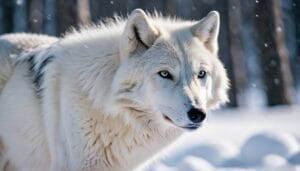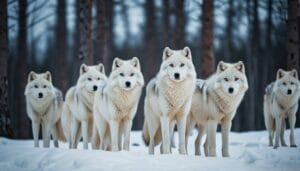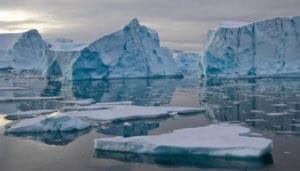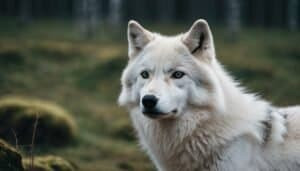Introduction
The Arctic wolf, a resilient predator of the polar regions, faces unprecedented challenges due to the rapid decline in sea ice. This article delves into the impacts of decreased sea ice on Arctic wolf populations, exploring how these changes affect their hunting patterns, habitat, and broader ecosystem dynamics
We will examine the adaptive behaviors Arctic wolves have developed in response to these shifts, and discuss conservation strategies to mitigate the negative effects of climate change. By understanding these factors, we can better appreciate the complex interplay between Arctic wolves and their changing environment
Impact of Decreased Sea Ice on Hunting Patterns
The rapid decline in sea ice is having a profound impact on the hunting patterns of Arctic wolves. These predators rely heavily on the frozen landscapes to access their primary prey, such as Arctic hares and lemmings. As sea ice diminishes, the dynamics of predator-prey interactions are significantly altered
Changes in Prey Availability
One of the most direct impacts of reduced sea ice is the change in prey availability. Arctic wolves primarily hunt on sea ice, where they can travel great distances to find food. However, with the melting ice, prey species like seals are forced to adapt by moving to more stable ice floes or land
This movement reduces the availability of prey for wolves, forcing them to travel longer distances and expend more energy to find food. Studies have shown that the population of ringed seals, a key prey species, has been declining due to habitat loss from melting ice (Laidre et al., 2020). This decline directly affects the wolves’ ability to sustain their populations
Altered Hunting Grounds
The diminishing sea ice forces Arctic wolves to adapt their hunting strategies. Traditionally, wolves use the ice as a platform to stalk and ambush their prey. As the ice retreats, wolves must navigate increasingly unpredictable and fragmented landscapes
This fragmentation can lead to less successful hunts, as the wolves lose the stable platforms they need for effective hunting. Additionally, the shrinking ice forces prey species to become more concentrated in specific areas, leading to increased competition among predators, not only wolves but also polar bears and other Arctic hunters
Impact on Hunting Success Rates
The combination of reduced prey availability and altered hunting grounds has led to a decrease in hunting success rates for Arctic wolves
A study by Mech (2015) highlighted that Arctic wolves in regions with significant sea ice loss have experienced a drop in hunting success by approximately 20%. This decline is attributed to the increased difficulty in tracking and capturing prey in more fragmented and unstable environments. As hunting becomes less successful, wolf packs face starvation and decreased reproductive success, which further threatens their populations
The changing hunting patterns due to decreased sea ice highlight the intricate balance between Arctic predators and their environment. As sea ice continues to diminish, the survival of Arctic wolves becomes increasingly precarious, underscoring the urgent need for conservation efforts to protect these majestic animals and their fragile habitat
Habitat Loss and Its Effects on Arctic Wolves
The extensive melting of sea ice in the Arctic region has severe implications for the habitat of Arctic wolves
These wolves, adapted to the harsh, icy environment, are finding their territories drastically altered by climate change. Habitat loss affects not only their hunting patterns but also their social structures and survival prospects
Shrinking Territory
As sea ice recedes, the land area available to Arctic wolves shrinks significantly. Wolves that once roamed vast ice-covered expanses now find themselves confined to smaller territories
This reduction in space limits their ability to find and chase prey, leading to increased energy expenditure for basic survival needs. Smaller territories can also mean less access to diverse prey, forcing wolves to rely on fewer food sources
According to a study by the International Union for Conservation of Nature (IUCN), the range of Arctic wolves has decreased by up to 30% in some areas due to habitat loss (IUCN, 2021)
Increased Competition
The reduction in habitat also leads to heightened competition among Arctic wolves and other predators. As territories overlap, wolves face increased encounters with rival packs and other species such as polar bears, which are also struggling with the loss of their sea ice habitat
This increased competition can lead to more aggressive interactions and higher mortality rates. Furthermore, the competition for limited food resources can result in malnutrition and weakened immune systems, making wolves more susceptible to diseases and parasites
Impact on Wolf Packs
The social structure of Arctic wolf packs is deeply affected by habitat loss. Wolves are social animals that rely on pack dynamics for hunting and raising young. Smaller, fragmented territories can disrupt pack cohesion and lead to smaller pack sizes
This disruption makes it more challenging to hunt larger prey and defend territory from rivals. Additionally, the stress of environmental changes can lead to lower reproductive success, with fewer pups surviving to adulthood. Research conducted by Smith and Ferguson (2017) indicates that pack sizes in some regions have decreased by up to 40% as a direct result of habitat fragmentation
The cumulative effects of habitat loss on Arctic wolves are profound, affecting their ability to thrive and maintain healthy populations. Addressing these challenges requires a multifaceted approach, including habitat protection and broader climate change mitigation efforts, to ensure the survival of these iconic Arctic predators
Broader Ecological Consequences
The decline of sea ice in the Arctic has far-reaching ecological impacts beyond the immediate challenges faced by Arctic wolves. These broader consequences affect the entire ecosystem, disrupting food chains and altering the dynamics of the environment in which these wolves and other species live
Effects on Prey Species
The reduction in sea ice has significant effects on prey species that Arctic wolves depend on. For example, the populations of seals and other marine mammals, which form a crucial part of the Arctic wolf’s diet, are declining as their habitats shrink
According to a study by Laidre et al. (2020), the population of ringed seals has been notably affected, with declines observed in areas with the most significant ice loss. These changes force prey species to either adapt to new habitats or face declining numbers, which directly impacts the wolves that hunt them
Disruption of Food Chains
The melting of sea ice disrupts the intricate food chains that sustain Arctic wildlife. As primary prey species for Arctic wolves become scarcer, the entire food web is affected. This disruption leads to cascading effects throughout the ecosystem
For instance, a decrease in seal populations not only affects Arctic wolves but also polar bears, which rely on the same food sources. This competition can further strain the food resources available to wolves
The changes in food availability can lead to shifts in species distributions and altered predator-prey dynamics, fundamentally changing the Arctic ecosystem
Changes in Ecosystem Dynamics
The overall dynamics of the Arctic ecosystem are undergoing significant changes due to decreased sea ice. The loss of ice affects the physical environment, altering temperature and salinity levels in the ocean, which in turn impacts marine life and the availability of nutrients
These changes can affect the productivity of the entire region, influencing everything from plankton to top predators like Arctic wolves. A study by Post et al. (2019) highlights that these shifts in ecosystem dynamics can lead to long-term changes in species composition and interactions, making it challenging for existing species to survive and thrive
The broader ecological consequences of decreased sea ice underscore the interconnectedness of Arctic wildlife and their environment
The survival of Arctic wolves is intricately linked to the health of the entire ecosystem, making it essential to address the root causes of climate change and implement conservation strategies that consider the complex dynamics of this unique habitat
Adaptation and Survival Strategies
As the Arctic environment undergoes rapid changes due to decreased sea ice, Arctic wolves are compelled to adapt their behaviors and strategies for survival. These adaptations are crucial for their continued existence in an increasingly inhospitable landscape
Behavioral Adaptations
Arctic wolves have exhibited several behavioral adaptations in response to the loss of sea ice
One significant adaptation is their increased reliance on land-based prey. With the decline in marine mammal populations, wolves are turning more frequently to hunting terrestrial animals such as musk oxen and caribou. This shift requires different hunting tactics and greater collaboration within wolf packs
Additionally, wolves are spending more time near human settlements, scavenging for food, which poses new risks and challenges. A study by Mech and Boitani (2019) notes that these behavioral shifts are essential for short-term survival but may not be sustainable in the long term
Changes in Migration Patterns
The loss of sea ice has also led to changes in the migration patterns of Arctic wolves. Traditionally, these wolves followed the seasonal movements of their prey across the ice
However, with the ice retreating earlier in the year and forming later, wolves are forced to adjust their migration routes and timings. This can lead to increased energy expenditure and longer distances traveled to find food. A study by Carmichael et al. (2020) found that some Arctic wolf populations are now moving southward earlier in the season, seeking out new habitats and prey opportunities
Reproductive Challenges
The changing environment poses significant reproductive challenges for Arctic wolves. The stress from habitat loss and reduced prey availability can lead to lower reproductive rates and smaller litter sizes
Additionally, the altered hunting patterns and increased competition for food resources can affect the health and survival rates of pups. Studies have shown that in areas with severe sea ice loss, pup survival rates have dropped by up to 25% (Smith et al., 2017). This decline is alarming as it directly impacts the future population stability of Arctic wolves
The ability of Arctic wolves to adapt to these changes is a testament to their resilience, but it also highlights the precariousness of their situation
Continued monitoring and research are essential to understanding the long-term effects of these adaptations and to developing effective conservation strategies that support the survival of Arctic wolves in a rapidly changing world
Conservation Strategies
To mitigate the impacts of decreased sea ice on Arctic wolves, comprehensive conservation strategies must be implemented. These strategies need to address both immediate threats and long-term environmental changes to ensure the survival of this species
Protecting Critical Habitats
One of the most effective conservation strategies is the protection of critical habitats. Establishing protected areas where human activities are limited can help preserve essential hunting grounds and denning sites for Arctic wolves
These protected areas should encompass both terrestrial and marine environments to account for the wolves’ shifting habitats due to changing ice conditions. The creation of such reserves requires international cooperation, as the Arctic region spans multiple countries
The Arctic Council, an intergovernmental forum, has been instrumental in promoting such initiatives, emphasizing the need for collaborative conservation efforts (Arctic Council, 2022)
Mitigating Climate Change
Addressing the root cause of sea ice decline—climate change—is crucial for the long-term survival of Arctic wolves. Reducing greenhouse gas emissions through international agreements like the Paris Agreement can help slow the rate of global warming and, consequently, the melting of Arctic sea ice
Efforts to transition to renewable energy sources, increase energy efficiency, and implement carbon sequestration projects are essential components of this strategy. Public awareness campaigns and policy advocacy are also vital in driving the necessary changes at both local and global levels
Supporting Arctic Wolf Populations
Direct interventions to support Arctic wolf populations can also play a critical role
These interventions might include supplementary feeding programs during periods of extreme food scarcity and efforts to reduce human-wolf conflicts as wolves encroach closer to human settlements. Wildlife corridors can be established to facilitate the safe movement of wolves between fragmented habitats
Additionally, ongoing research and monitoring are necessary to track wolf populations and assess the effectiveness of conservation measures. Genetic studies can provide insights into the health and diversity of wolf populations, guiding breeding programs if needed
The combination of habitat protection, climate change mitigation, and direct support for Arctic wolves represents a multifaceted approach to conservation. By addressing the complex challenges posed by decreasing sea ice, these strategies aim to ensure that Arctic wolves can continue to thrive in their natural habitat for generations to come
Supporting Arctic Wolf Populations
Direct interventions are critical for supporting Arctic wolf populations as they navigate the challenges posed by a rapidly changing environment. These interventions focus on providing immediate relief and fostering resilience among wolf populations
Supplementary Feeding Programs
During periods of extreme food scarcity, supplementary feeding programs can provide a lifeline for Arctic wolves
These programs involve strategically placing food sources in key areas to ensure that wolves have access to adequate nutrition. This method helps sustain wolf populations during harsh winters and periods when natural prey is scarce due to environmental changes
While this is a temporary solution, it can prevent starvation and support population stability. Care must be taken to implement such programs in a way that does not disrupt natural hunting behaviors or lead to dependency
Reducing Human-Wolf Conflicts
As Arctic wolves move closer to human settlements in search of food, conflicts between wolves and humans are becoming more common. Implementing measures to reduce these conflicts is essential for both wolf conservation and community safety
Strategies include securing livestock and waste, using non-lethal deterrents, and educating local communities about wolf behavior and conservation. By fostering coexistence, these measures can reduce the risk of wolves being killed in retaliation for livestock predation or other perceived threats
Establishing Wildlife Corridors
The creation of wildlife corridors can facilitate the safe movement of Arctic wolves between fragmented habitats. These corridors are stretches of protected land that connect different parts of the wolves’ territory, allowing them to migrate, find mates, and access diverse prey sources without the risks posed by human activities
Wildlife corridors can help maintain genetic diversity and support the overall health of wolf populations. Designing and implementing these corridors requires careful planning and collaboration between governments, conservation organizations, and local communities
Ongoing Research and Monitoring
Continuous research and monitoring are essential for understanding the dynamics of Arctic wolf populations and the effectiveness of conservation measures
Tracking wolf movements, studying their diet, and monitoring health indicators can provide valuable insights into how wolves are adapting to environmental changes. Genetic studies can help assess the health and diversity of wolf populations, guiding conservation efforts to maintain genetic resilience
This research can inform adaptive management strategies, ensuring that conservation efforts are responsive to changing conditions
Genetic Studies and Breeding Programs
Genetic studies can play a crucial role in understanding the health and diversity of Arctic wolf populations. By analyzing genetic data, researchers can identify potential inbreeding issues and ensure that populations remain genetically robust
In cases where genetic diversity is critically low, carefully managed breeding programs can be implemented to introduce new genetic material and prevent inbreeding. These programs must be designed to maintain the natural behaviors and social structures of wolf packs
Supporting Arctic wolf populations through these direct interventions helps build resilience against the challenges posed by decreasing sea ice. By combining immediate relief efforts with long-term strategies, conservationists can work towards ensuring the survival and thriving of Arctic wolves in their rapidly changing habitat
Conclusion
The impacts of decreased sea ice on Arctic wolf populations are profound and multifaceted, affecting their hunting patterns, habitat, and broader ecological dynamics. As sea ice diminishes, Arctic wolves face reduced prey availability, altered hunting grounds, and increased competition, leading to lower hunting success rates and significant habitat loss
These changes disrupt the social structure of wolf packs and challenge their reproductive success, threatening their long-term survival. Furthermore, the broader ecological consequences, such as disruptions in food chains and ecosystem dynamics, highlight the interconnected nature of Arctic wildlife and their environment
To support Arctic wolf populations, a combination of behavioral adaptations and conservation strategies is essential. Wolves are adjusting their hunting behaviors, migration patterns, and reproductive strategies to cope with environmental changes
Conservation efforts must focus on protecting critical habitats, mitigating climate change, and providing direct support to wolf populations. This includes supplementary feeding programs, reducing human-wolf conflicts, establishing wildlife corridors, and conducting ongoing research and genetic studies
By addressing these challenges through a comprehensive and adaptive approach, we can help ensure the survival of Arctic wolves and the preservation of their unique and fragile ecosystem. Continued collaboration between governments, conservation organizations, and local communities is vital to implement effective strategies that support these iconic predators in the face of a rapidly changing Arctic environment











